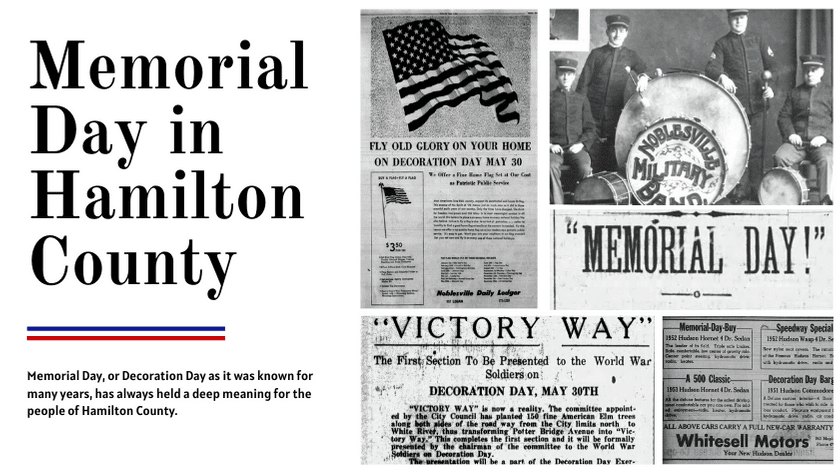By David Heighway, Hamilton County Historian
Memorial Day, or Decoration Day as it was known for many years, has always held a deep meaning for the people of Hamilton County. The county provided the first soldiers from Indiana to enlist in the Union army during the Civil War. After they returned from the war, the veterans continued to feel strongly about their service and the sacrifice of their compatriots. There are many stories about the origin of the holiday, but its history in Hamilton County is pretty clear.
In a sense, the dedication of the monument at Crownland in 1868 was the first celebration in the county. This was the same year that the head of the national veterans group called the Grand Army of the Republic (G.A.R.) proclaimed May 30 as “Decoration Day”. In 1871, Michigan made the date a state holiday and other states soon followed.
Hamilton County started celebrating Decoration Day in 1872. We don’t have all of the newspapers from that time period, so the first mention of the holiday is on May 28, 1875. The newspaper also reported when the May 30 date was officially chosen by the G.A.R. in 1877, and when the name was changed to “Memorial Day” by the G.A.R. in 1883. However, locally, both names were used interchangeably until the 1960’s.

Some year’s events were bigger than others. There was a long article in the newspaper in June of 1883 describing the Memorial Day exercises. In Noblesville, a major factor in organizing the event was dividing the time between the Old Cemetery (Riverside) and the new cemetery (Crownland). For many years, Riverside had a large stone that served as a speaker’s stand. It has been replaced with a concrete block platform.
 There was also a difference in the layout of the two cemeteries. Riverside had been created as a simple burial ground with no thought as to how it would look. Crownland was created as part of the “garden cemetery” movement and was carefully landscaped with trees, curved paths, and rolling ground. On Decoration Day In 1901, the woman’s auxiliary of the G.A.R. dedicated a large monument to unknown soldiers. At one time, people would have picnics in the cemetery as a part of the event.
There was also a difference in the layout of the two cemeteries. Riverside had been created as a simple burial ground with no thought as to how it would look. Crownland was created as part of the “garden cemetery” movement and was carefully landscaped with trees, curved paths, and rolling ground. On Decoration Day In 1901, the woman’s auxiliary of the G.A.R. dedicated a large monument to unknown soldiers. At one time, people would have picnics in the cemetery as a part of the event.
An interesting side note – on Decoration Day in 1900, local resident Tie Loy visited the grave of his child in Crownland Cemetery. Tie Loy was an immigrant from China who apparently still followed traditional customs. He left a box on the grave containing strawberries, bananas, cheese, crackers, and other food.
 In the early days, Carlin’s Silver Cornet Band usually provided music for the event. After the Noblesville Military Band was organized in 1900, it supplied the music for the first half of 20th century.
In the early days, Carlin’s Silver Cornet Band usually provided music for the event. After the Noblesville Military Band was organized in 1900, it supplied the music for the first half of 20th century.
The new century saw some changes in the event. Spanish-American war casualties were recognized in the ceremonies in 1901. Also in 1901, the chaplain of G.A.R. was Barney Stone, an ex-slave and Civil War veteran. He was asked to speak that year and spoke many times after that. People remember him as a good speaker, but he tended to talk for a long time. He lived until 1941, and there are people alive today who remember hearing him speak.
A new element of the day after 1911 was the Indianapolis 500 Speedway race. In 1913, the newspaper reported that some local people went, but most people were not comfortable with having a sporting event on same day they recognized the war dead – particularly a race as dangerous as the 500. In 1914, a local minister called the race a “carnival of blood” and “desecration of Decoration Day”.
 Commercialization of the event had begun early. A local business had a large advertisement in the paper in 1892 for selling flags. The newspaper itself did the same in 1967. A local car dealership used the day to sell cars in 1953, using both names for the day and references to the 500 race.
Commercialization of the event had begun early. A local business had a large advertisement in the paper in 1892 for selling flags. The newspaper itself did the same in 1967. A local car dealership used the day to sell cars in 1953, using both names for the day and references to the 500 race.
Wars usually revived the significance of the holiday. After World War One, 10th Street was renamed Victory Way for a short time. For the event in 1920, volunteers planted elms along the road between the city limits (Central Avenue) and Potters Bridge.
It would be interesting to see how this year’s Memorial Day will be remembered in the future. With the pandemic and the cancellation of so many events, it looks very different from years past. When you live in the midst of great historical events, it’s hard to envision what it will mean a long time from now.
